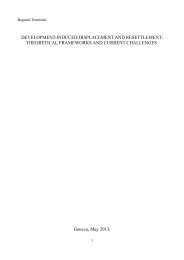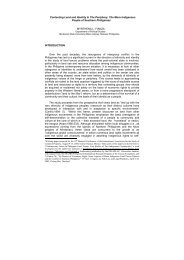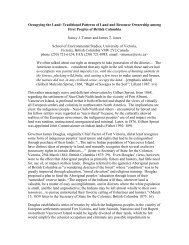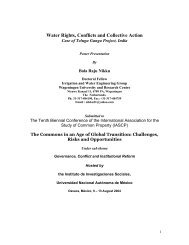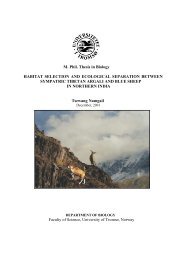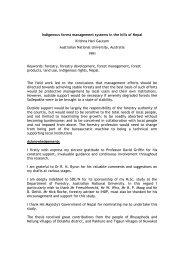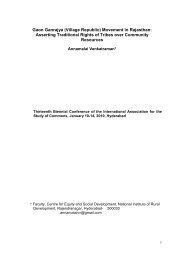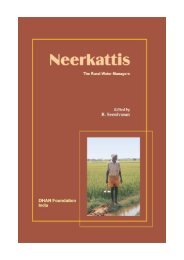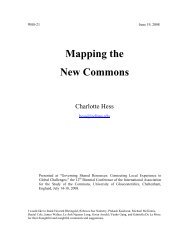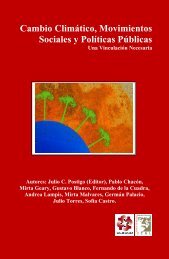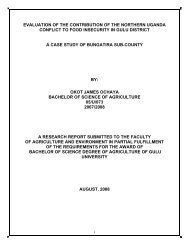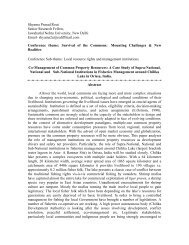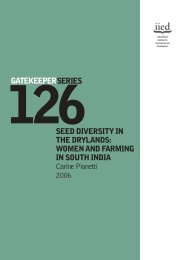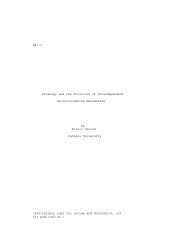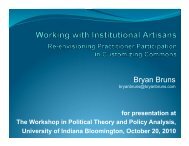Legal empowerment for local resource control
Legal empowerment for local resource control
Legal empowerment for local resource control
Create successful ePaper yourself
Turn your PDF publications into a flip-book with our unique Google optimized e-Paper software.
Yet, overall, the security of <strong>resource</strong> rights is problematic <strong>for</strong> both <strong>for</strong>eign<br />
investors and <strong>local</strong> <strong>resource</strong> users in much of sub-Saharan Africa. This is due<br />
to ill-drafted and/or ill-coordinated laws, weak government capacity to<br />
en<strong>for</strong>ce them, limited effectiveness and independence of the judiciary and<br />
other factors.<br />
Within this, ef<strong>for</strong>ts to secure <strong>resource</strong> rights have tended to focus on <strong>for</strong>eign<br />
investment. As a result, the legal protection of <strong>resource</strong> rights tends to be<br />
differentiated: the <strong>resource</strong> rights of some are granted greater protection<br />
than those of others. This differentiation broadly reflects asymmetries in<br />
power relations between actors – with <strong>for</strong>eign investors tending to enjoy<br />
greater protection than <strong>local</strong> <strong>resource</strong> users.<br />
Universal principles but differentiated rules: the protection of property<br />
under international law as it applies to Africa<br />
At the international level, security of <strong>resource</strong> rights is influenced by the<br />
international rules on the protection of property. The right to property<br />
affirmed by international human rights law protects both the <strong>resource</strong> rights<br />
of <strong>local</strong> groups affected by large-scale investment projects, and the property<br />
rights of <strong>for</strong>eign investors. In addition, <strong>for</strong>eign investment is also protected<br />
under international economic law. This includes norms on the protection of<br />
<strong>for</strong>eign property, which extends to <strong>resource</strong> rights based on contracts<br />
between the investor and host state (e.g. <strong>for</strong>est or mining concessions). 10<br />
International economic law protecting <strong>for</strong>eign property emerged in the 19th<br />
century. In the 1960s and 70s, it <strong>for</strong>med the object of considerable debate<br />
between capital-exporting and capital-importing states. More recently,<br />
polarisations have given way to a significant strengthening of the protection of<br />
<strong>for</strong>eign property, in many respects well beyond the protection granted to<br />
nationals. This includes:<br />
The development of international rules on the taking of <strong>for</strong>eign property,<br />
particularly those establishing the conditions <strong>for</strong> the legality of takings<br />
(public purpose, non-discrimination, due process and payment of<br />
10. International arbitrators have consistently adopted a very broad definition of property rights, including<br />
“all interests and rights which […] may be evaluated in financial and economic terms” (Liamco v. Libya);<br />
and “any right which can be the object of a commercial transaction […] and has thus monetary value”<br />
(Amoco v. Iran). Broad definitions of property rights are also used in virtually all bilateral investment<br />
treaties. As a result, breaches of investors’ contractual rights have been treated as takings of property, with<br />
implications <strong>for</strong> the strength of the protection of <strong>for</strong>eign investors’ assets (see e.g. the cases BP v. Libya;<br />
Texaco v. Libya; Aminoil v. Kuwait).<br />
29



